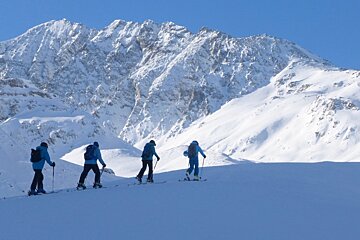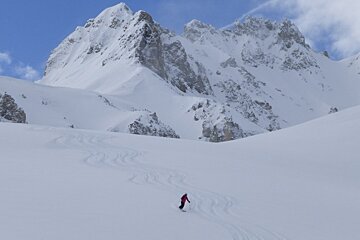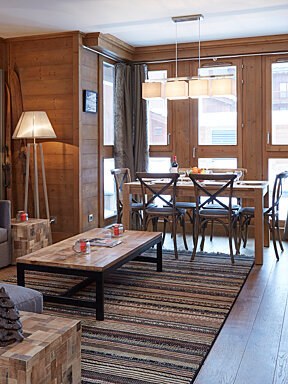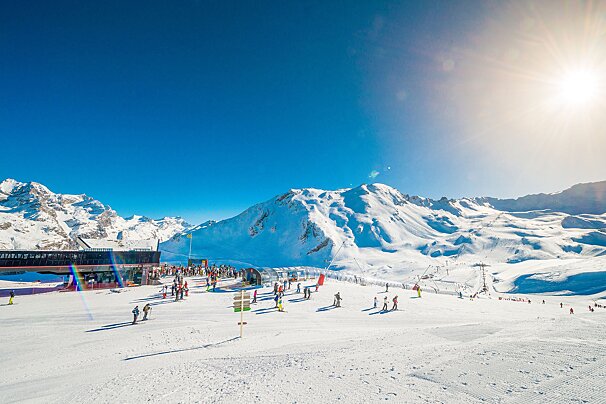
© Wayne Watson

© Wayne Watson

© Wayne Watson

© Wayne Watson

© Jordan Tiernan
Off-piste Ski Areas in Val d'Isere
Discover the top Val d'Isere off-piste skiing
Given the size of the Espace Killy ski area, it's probably no surprise to hear that there are plenty of places to head on a good powder day, for almost endless off-piste skiing and snowboarding possibilities.
Val d'Isère and Tignes have some great off-piste skiing and with the number of fast and easily accessible lifts accessible to you, great off-piste skiing is never hard to find.
Always make sure you are prepared before embarking on some off-piste skiing, check out our avalanche safety page for tips on what to do before setting off. It is also always advisable to hire an off-piste guide who will have extensive knowledge of the area and the mountains.

Off-piste skiing in Val d'Isère
Solaise
Slightly less off-piste but plenty for the thrill seeker to enjoy.
The Lavancher Couloir: from the top of the Solaise Express, turn left perpendicular to the chairlift. The slope gets gradually steeper and opens out into a wide wall. The couloir is below and to the left of this flat section. It's more than 5m all the way down but is quite steep and continues towards Val d’Isère through the trees.
The Super L, from the start of Piste L, follow the Iseran route which leads to the start of the Mattis. Throughout the whole length you can always turn left off-piste to the bottom of the Laisinant valley. The closer you get to the start of the Mattis, the greater the drop.
Bellevarde
The most off-piste skiing with three particularly well known off piste slopes.
The Banana, this is a very large vertical drop. The snow here heats up early so aim to ski this section in the morning. Go down the start of the Face from the top of the Olympique cable car and at the first bend to the left, continue straight on past an obvious rock on the right hand side. The first slope is very easy and leads to a level area with rocks at the end. Go left of these rocks down to another level section before taking the slope right down to the bottom of Santons.
The Charvet Tour, this is the best-known off-piste run in Val. Because of its south-facing aspect however, there is a high risk of snow-sliding so be especially wary in the afternoon. Take the Grand Pré chairlift and at the top, carry on along the line of the lift before cutting in right at the large flat area. From here, the less experienced skiers can continue traversing to the right towards the far end of the bowl and then follow the bottom of the valley back to the left. Others may prefer to go straight down. Depending on the snow cover, you can take either bank of the Charvet stream towards the gorge, a narrow but lovely pitch. From here, follow the slight descent beside the river to the Manchet valley and ending up at the Manchet Express chairlift.
The Face du Charvet, here you can find lots of challenging slopes, which incur more avalanche risks, and more risk of taking the wrong route. Stay high in the traverse of the South face to avoid cliffs, the long traverse will lead to a wide couloir which will then take you back to the village. The ski down is full of long steep descents.
La Daille
In La Daille you can enjoy a few off-piste tracks and fresh powder. There is also extensive off-piste around this area which involves no walking or climbing, simply powder practice. In addition, just off the top of the Tommeuses lift, to the side of the Creux, is a pitch of moguls which come and go throughout the winter season. There are also the ‘naturide’ runs (Paquerettes at the top of the Tommeuses), which are left un-groomed for skiers and boarders to negotiate more difficult terrain.
The Lost Valley
This run can involve picking ones way through rocks and branches along a narrow path but it is one of the most beautiful in resort and can be a lot of fun. It can be reached by passing above the bottom station of the Tommeuses chairlift and dropping down to the right. Follow this canyon down through the tricky passages to the La Daille buildings.
Le Fornet
Tends to be the quieter side of the Val d'Isère mountains, so the off-piste here can often be left untouched, providing fresh powder and plenty of fun.
The shoulder of the Petit Signal, from the top of the Signal lift. Go over the col and traverse immediately to the left. Go along the crestline and ski down to the foot of the rock tower at the top of Petit Signal. Traverse to the right of this block, and then ski down a few metres, across a cornice to a wide hilltop. From here, head to the top of the Fornet cable car which you can see easily.
The Great Pissaillas, this run is very close to the slopes and lifts and the snow conditions are good due to the altitude. From the top of the Cascade Express, ski down the Moraine run until you reach a long, level stretch. From here, you can leave the piste wherever you want. To avoid any danger, stay near the lift cables.

Off-piste skiing in Tignes
Les Brevieres
Tignes Les Brevieres has some lovely off-piste skiing and can be especially handy when it is a white out as you can pick and choose some lines in between the trees.
From the top of the Aigulle Percee chairlift if you head to the right there is some off piste that you can tackle, but be warned the mountains can leave you stranded at the bottom not knowing which way to go so make sure you have a mountain guide with you or plan your route extremely carefully.
There are also plenty of off piste sections to slide down by the side of the marked runs and pistes, and normally from the lifts you can spot the best off piste snow next to the runs.
Tignes Le Lac
The off piste skiing in Le Lac is not that vast, however there is plenty of fun to be had on the side of the pistes and you're never short for finding some powder to play in.
If you find yourself in Tignes Le Lac on a powder day then you can enjoy lots of the white stuff near the Chardonnet lift, Palafour lift and can then head over to the L'Aiguille Percée and Tignes Les Brevieres for the off-piste skiing there. Try under the Grand Huit lift for some fresh tracks after a snow fall.
Tignes Val Claret
Does not have a huge amount of off-piste skiing routes but you can always stick to the side of the pistes and play in the deeper snow there.
If you head up the Tichot chairlift and then up the Grattalau you can hike from the top of the Grattalau either going right or left, and explore some of the off piste drops from there.
Coming down the Grande Motte to the left of the Double M there is a small bowl where some lovely soft powder can sometimes be found, just make sure you cut across high enough up so you don't have to walk up the other side of the bowl.
Overall, the Grande Motte will have some soft fresh powder snow to the sides of the pistes and if you get up there first after a fresh snow dump you can make the first off piste tracks.

Before heading off-piste
Before you head off piste, here's a few things you should be thinking about:
- hire a guide
- take a course in avalanche awareness and practice the techniques learned
- look at the weather and avalanche forecasts for France, reviewing the degree of local avalanche risk also
- don’t ignore advice given by local mountain guides or others if advised to ski a certain path, or to keep a specific distance between fellow members in a group
- plan the route carefully, evaluating all different options and assessing all elements of danger
- look at the timings for each route and inform others of your route, and when you expect to arrive back
- attach your transceiver properly TO YOU and DON'T FORGET to turn it on, test the signal is working, and make sure you have all the necessary equipment
- a transceiver is of no use if the user has not been trained in its use, it is turned off, or it is in a rucksack - unless you want just your bag to be recovered
Read more about understanding avalanches and how to try to avoid them.
More inspiration...
Take a look at this year's ski pass prices or find your way around with piste maps for Val d'Isere.
































